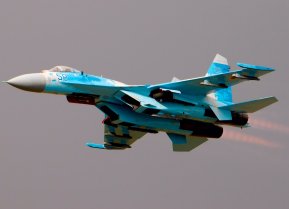Su-37: Russia's 'Terminator' Fighter History Seems to Have Forgotten
The eleventh Su-27M, or upgraded Su-27, designated T10M-11 rolled off the production line in early 1995, the airframe was redesignated the Su-37 and given to designers to test a myriad of new systems and equipment.
The mid-to-late twentieth century saw impressive advancements in fighter aviation due largely to the ongoing arms race between the U.S. and the Soviet Union. The Soviets developed the Mig-25 which caused the U.S. to rush to improve the F-15 Eagle.
The U.S. introduced the F-14 Tomcat, and the Soviets designed the Su-27 to match it.
These impressive leaps in design led to incredible technological advance in a short time, as seen on the Su-37.
A Brief History of the Su-37
Entering service in 1985, the Sukhoi Su-27 “Flanker” was a highly successful aircraft developed into several different platforms, the -30, -33, -34, and -35, with multiple capabilities and mission roles. Born out of the Flanker, the -37 or “Terminator”, was built to test a variety of new features and upgrades to improve the capabilities of the Su-27.
The eleventh Su-27M, or upgraded Su-27, designated T10M-11 rolled off the production line in early 1995, the airframe was redesignated the Su-37 and given to designers to test a myriad of new systems and equipment.
While some of the initial tests were simply on new radar systems, these proved incredibly capable. The new radar, N011M Bars, could lock onto and track twenty targets. The old radar on the Su-27 could only handle fifteen.
Pilots interfaced with this new radar as well as upgraded avionics using four full-color LCD multi-function displays.
These displays provided more functionality as well as a better picture in bright sunlight. By far the most significant improvement, however, was the addition of thrust vectoring nozzles to the engine.
The Su-27M was one of the first airframes to incorporate thrust vectoring
Initial testing of the Su-27M revealed that pilots were unable to maintain control at high angles of attack, that is the aircraft became difficult to maneuver at slow speeds. Beginning in 1983, Soviet designers had experimented with thrust vectoring which would allow the pilot or aircraft to change the direction of thrust produced by the engine by means of movable nozzles.
All jet aircraft up to that point had used fixed nozzles which meant the only way to maneuver was using flight controls. Thrust vectoring then was a novel idea that potentially had the ability to reshape dogfighting tactics.
Although Sukhoi was unable to equip the Su-37 with a new and powerful engine, they were able to install thrust-vectoring nozzles capable of deflecting up to fifteen degrees. Testing immediately revealed the capabilities of the new aircraft and at its debut in the Farnborough Airshow in September, 1996, spectators were enthralled by the Super Cobra maneuver, a variation of Pulgachev’s Cobra whereby the pilot pulls the aircraft to near vertical without gaining any altitude, slowing their airspeed to nearly zero and causing a pursuing aircraft to overshoot.
In the Super Cobra, Russian Pilot Yevgeni Frolov began the maneuver but carried it past the vertical. He then pushed the nose straight up and held the position momentarily before allowing it to fall back to level flight.
Over the next five years, the Su-37 would fly multiple times at different air shows as well as in test flights, proving its capabilities over and over.
Ultimately, it would crash in a test flight in 2002 when the left horizontal stabilizer broke off, likely due to exceeding g-limits multiple times over the course of its life.
Maya Carlin is an analyst with the Center for Security Policy and a former Anna Sobol Levy Fellow at IDC Herzliya in Israel. She has by-lines in many publications, including The National Interest, Jerusalem Post, and Times of Israel.
The image is of a Su-27 fighter. Image Credit: Creative Commons.


